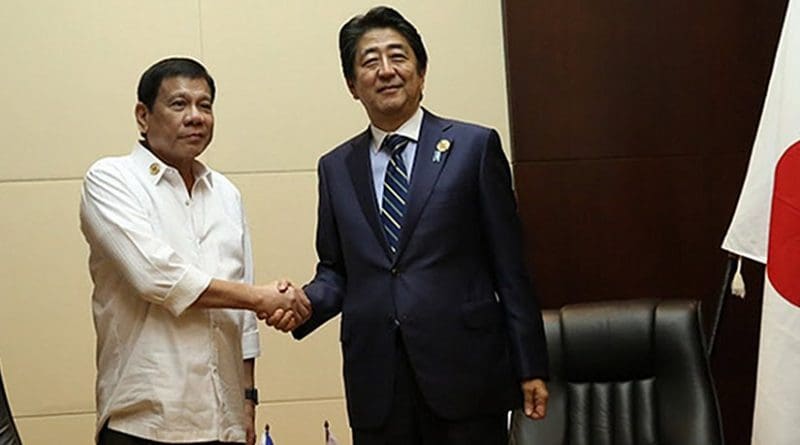China-Philippines Ties: Lessons For India And Japan – Analysis
By IPCS
By Tapan Bharadwaj*
China and Philippines are in discussion to establish a bilateral consultation mechanism on South China Sea (SCS). This could re-establish direct talks between both countries after a long pause of six years. This upswing in bilateral ties however is a placebo. While China’s strategic position will almost certainly improve in the region, the Philippines stands detached from traditional allies, with some trade deals to gain from Beijing at best.
By aspiring to be a net security provider in this region, China is challenging US’ presence and its provision of security to the sea lines of communication (SLOCs). However, the Chinese military does not currently have the capability to take on this role. Above all, the role is unlikely to be neutral as China itself has territorial claims in the region and is still in disputes with India and Japan on territory-related issues.
Almost 55 per cent of India’s total trade, 85 to 90 per cent of Japan’s oil imports, and 33 per cent of its LNG imports pass through the (SLOCs) in this area. This gives both India and Japan critical commercial interests in the region of the dispute even though they are not parties to the dispute itself.
Commerce through the region has become much more dangerous with a sharp increase in piracy in the region. China does not recognise the freedom of military navigation, which means that Indian and Japanese commercial traffic cannot be protected by any security provider other than China. The visuals of such a situation are alarming to both India and Japan. Hence, turning a blind eye and ignoring the developments in the SCS can cause severe economic disruptions for both countries.
India is currently bogged down in Chinese activities in the Indian Ocean, and Japan in the East China Sea. This effectively means that both India and Japan are playing one game each, while China is playing three games simultaneously. It is then clearly myopic for both India and Japan to ignore Chinese activities in the SCS because it represents the first line of defence. If China gets away unchallenged in this region, its normal and natural tendency will be to expand towards hegemony in all three domains. Holding China down in the SCS ensures that its navy remains a defensive littoral navy, whereas allowing it to break out from the SCS dispute will mean that China will naturally transition to a big, power projecting navy across Asia.
The problem that both countries face however is that some countries in the region are notoriously fickle and unreliable. For example, the Philippines has disowned its traditional strategic alliance with the US and sought to engage China bilaterally in the hope of finding a better deal. This has created a severe dilemma for any country seeking to support the regional disputants against China. The fear is that they will be used to forward a local agenda, but sold out at the negotiating table, much like President Rodrigo Duterte did.
However the good news is that Duterte’s gamble does not seem to have paid off, and with the benefit of hindsight, he may have been much better off retaining the help of the US. For example, Duterte’s ‘ice-breaking’ visit to China in October 2016 – which included meeting with Xi Jinping, Li Keqiang, and other important leaders, and the signing of thirteen agreements covering a wide range of subjects – delivered absolutely no concrete benefit for the Philippines, save some investment and photo opportunities. These improved ties have neither led to a softening of China’s territorial claims in the SCS nor have they led to any decrease in the aggression of China’s military patrolling and construction activities.
The Centre for Strategic and International Studies (CSIS) published a report on 27 March 2017 which stated that China had nearly finished constructing aircraft hangers, radar sites, surface-to-air missile shelters and runways on three of China’s largest artificial islands, Fiery Cross, and Subi and Mischief Reefs, all part of the Spratly islands. These islands are at the heart of the SCS dispute. Further, President Duterte’s less than stellar results seem to have spurred internal opposition to his rapprochement with China. Defence Secretary Delfin Lorenzana remained openly suspicious, citing ever more provocative Chinese patrolling – closer to the Philippines than before.
On 6 April, Duterte seemed to finally reverse course by asking troops to occupy uninhabited islands and shoals the Philippines claims in the disputed SCS, which contradicts what he said in March – that it was pointless to challenge China’s fortification of man-made islands in SCS: “We cannot stop them because they are building it with their mind fixed that they own the place. China will go to war,” he said.
The Philippines’ current conundrum may be an object lesson for the rest of ASEAN: that abandoning old and trusted allies for misguided faith in the benevolence and magnanimity of China will not yield results, and may severely weaken leaders attempting such rapprochement domestically. In that object lesson lies the opportunity for India and Japan to re-engage with the region.
* Tapan Bharadwaj
Researcher, CRP, IPCS


Good analysis. Thanks.